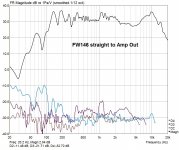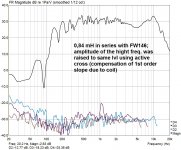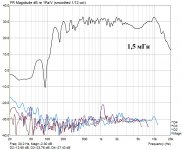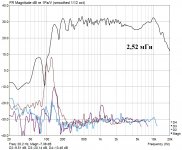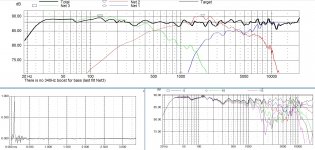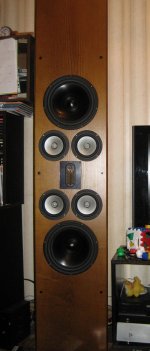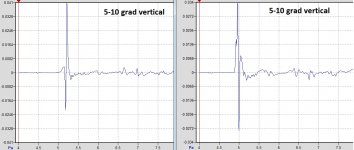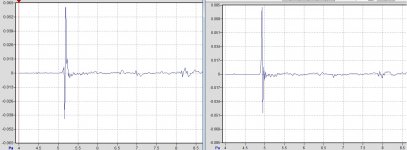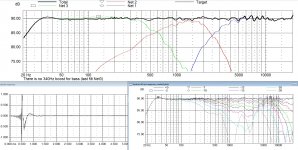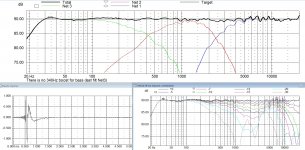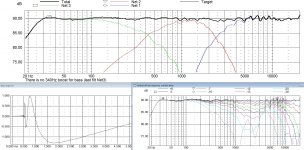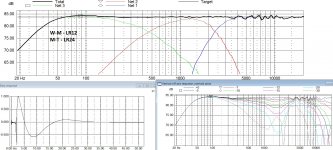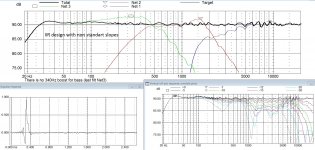DIY, active and DSP... my project would fit:
http://www.diyaudio.com/forums/full-range/242171-making-two-towers-25-driver-full-range-line-array.html
Though it is without any crossovers and even though many speakers were used it isn't a multi way. Still, it's active and a lot of processing experiments in there...
There are a lot more fun projects on here that fit the bill too. How far do you want to go? To me, something like the Kii still seems quite reasonable as a goal, the Beolab however is quite out there. I love it! Sadly I didn't get to hear it yet. Maybe some day.
I will check it out!
I am willing to go very far. I'm already deep in the rabbit hole with my last project. I might as well go all the way down.
I'm surprised the Kii is a reasonable goal. The pattern control down to 40Hz seems unachievable with DIY components. It seems to have additional DSP psychoacoustics optimization from a YouTube video I watched. The sound is unnatural, but it just sounds so pleasing to the ear.
btw, years ago I discussed with Bruno what to consider when using UCD modules with an external loop to implement current drive, and it is quite tricky when you want to have high output-Z at high frequencies because of the low bandwith, but al low/medium frequencies it is relatively easy to implement... at least with single-ended output (bridged outputs less so).
So this is the good about UCD modding. I had assumed current driving for all channels but I found Bruno statement that current driving at the tweeter wasn't benefficial.
Current-Driving of Loudspeakers
I am almost certain that he was thinking of DXT tweeter. He admitted in that thread that current drive is suitable only when some sort of motional feedback from the driver is available to process. I think it is realised in DSP digitally where kind of SHARC processor is computing the waveform corrections on realtime information based on kind of motional feedback. This leads to conclusion that only subwoofer channel can benefit from current drive in reality.
Last edited:
The Rational Audiophile blog has been documenting the writer's explorations into DSP active speaker systems. He is using software to implement the system and not exactly high end drive units, but reporting good results. His thinking is documented so might prove a useful starting point.
https://therationalaudiophile.wordpress.com/the-project/
https://therationalaudiophile.wordpress.com/the-project/
That blog is interesting but, as written, he does seem to think that DSP will make a silk purse out of a sows ear and all you need is FIR crossovers and all is well with the world. He is good at software so of course he will focus on that but very little discussion on directivity, polars, diffraction etc.
Very interesting thread, haven't seen that before (one cannot monitor all forums when you have a full time day job ;-). So the LS1 Woofer in fact runs on frequency dependant output impedance (raising impedance above the system resonance region), while the tweeter runs from a normal voltage amp.
I might share that the ADAM F5 and F7 monitors (for which I designed the electronics, during my time there) also use(d) freq. dependant drive impdedance on the woofer while the AMT tweeter runs full current drive. Payed off big time sonically I think (but I'm biased of course) and it was quite feasible to implement despite the very constrained budget. They might have changed that now under new ownership to save even more cost...
The Rational Audiophile blog has been documenting the writer's explorations into DSP active speaker systems. He is using software to implement the system and not exactly high end drive units, but reporting good results. His thinking is documented so might prove a useful starting point.
https://therationalaudiophile.wordpress.com/the-project/
Rational stuff, but as biased as life! Thanks for sharing though...
For half a handfull of ferrite coils and bipolar caps...
http://www.audiophonics.fr/en/diy/sure-adau1701-module-processeur-signal-digital-p-11212.html
Nothing's costs nothing and nothing's worth nothing anymore, fuckin life!
http://www.audiophonics.fr/en/diy/sure-adau1701-module-processeur-signal-digital-p-11212.html
Nothing's costs nothing and nothing's worth nothing anymore, fuckin life!
Last edited:
For half a handfull of ferrite coils and bipolar caps...
SURE ADAU1701 DSP Audio Digital Signal Processor Kernel Board - Audiophonics
Nothing's costs nothing and nothing's worth nothing anymore, fuckin life!
Does Sigma Studio actually give all those DSP algorithm capabilities to that little board? If it does, it seems like it is far more powerful than the miniDSP at 1/5 the price.
Does Sigma Studio actually give all those DSP algorithm capabilities to that little board? If it does, it seems like it is far more powerful than the miniDSP at 1/5 the price.
Same chip, used in hypex AS2100 too... Almost obsoleeete! Next year or the other almost any cheap chinese pa amplified speaker will be based on it or almost as bad eq!
Hope i have made clear how bad it sucks!
Last edited:
Isn't a DIY active DSP design going to be unique ?
...or at least customized to a particular set-up? The "Rational Audiophile" is great for DIY, however most of us, even if we have (ahem ) a BS in Computer Science, could write our own DSP code. Of course, DSP is easily available at prices from nearly free (runs on your PC) to "how much $ you got?"
) a BS in Computer Science, could write our own DSP code. Of course, DSP is easily available at prices from nearly free (runs on your PC) to "how much $ you got?" 
Now, let me be the first to admit that my hardware skills are pretty awful, hence my handle here, and (usually) the quality of my hardware frequently has names like Bose, Behringer and ... well you get the point.
Seems to me that DSP answers a huge number of needs in a home stereo, at least. Even if you only do frequency correction and/or crossover (me, so far), it is amazing what these cheap chips can do. I admit I won't make my $300-the-pair Bose 901's sound like [insert your choice of speakers costing as much as a new car] but vastly improved? Yes. Or, as I like to say, you CAN make a silk ear out of a sow's purse
The big pain in the **** is that DSP always has to be customized to the specific need. Even all those GUI and stuff need a little bit of tech savvy and it's great for the poor hobbyist but still a mystery for the average humanoid who is lucky to just be able to find the volume and channel selector
...or at least customized to a particular set-up? The "Rational Audiophile" is great for DIY, however most of us, even if we have (ahem
Now, let me be the first to admit that my hardware skills are pretty awful, hence my handle here, and (usually) the quality of my hardware frequently has names like Bose, Behringer and ... well you get the point.
Seems to me that DSP answers a huge number of needs in a home stereo, at least. Even if you only do frequency correction and/or crossover (me, so far), it is amazing what these cheap chips can do. I admit I won't make my $300-the-pair Bose 901's sound like [insert your choice of speakers costing as much as a new car] but vastly improved? Yes. Or, as I like to say, you CAN make a silk ear out of a sow's purse
The big pain in the **** is that DSP always has to be customized to the specific need. Even all those GUI and stuff need a little bit of tech savvy and it's great for the poor hobbyist but still a mystery for the average humanoid who is lucky to just be able to find the volume and channel selector
Does Sigma Studio actually give all those DSP algorithm capabilities to that little board? If it does, it seems like it is far more powerful than the miniDSP at 1/5 the price.
I think MiniDSP is ADAU1702. The SURE board is only half what you need. There is no GUI and no way you can program it. You need an add-on module (99$) and sigma studio.
You can get some very cheap ADAU1701/1702 board with GUI and programming interface for very little money (20$-30$), but you have to buy at least 20 boards, and freight, customs etc will come on top of that.
A good active speaker should looks like in pictures.
P.S. there is only IIR filters so there is no additional big delays. And also 1,5mH coil in series for mid section to reduce thd due to metallic cone resonance.
Isn't it FIR filters that can be linear phase and IIR ones have the same phase problems as analogue ones?
A good active speaker should looks like in pictures.
P.S. there is only IIR filters so there is no additional big delays. And also 1,5mH coil in series for mid section to reduce thd due to metallic cone resonance.
A series coil is not going to reduce non-linear distortion. As for linear distortion, well that should have been taken care of by your filters. The coil is totally uneeded.
Are the individual driver plots the raw, unfiltered response?
The only way to make it better - FIR filters with high order slopes with some amount of 20...300ms additional delay.^That doesn't look any good to me. Destructive acoustic summing is a complete no-go in my book, and consequently the vertical off-axis behaviour is a disaster.
FIR filters can make what ever you want. The only downside is that you need more length for low freq. with big additional delays.Isn't it FIR filters that can be linear phase and IIR ones have the same phase problems as analogue ones?
IIR filters could be made in analog (active OPAMP or passive networks).
The coil is totally neddedA series coil is not going to reduce non-linear distortion. As for linear distortion, well that should have been taken care of by your filters. The coil is totally uneeded.
Are the individual driver plots the raw, unfiltered response?
Attachments
No, normal analog filters (including allpass) will do to make a very good XO in 99% of cases.... unless your choice of drivers and/or overall construction is atypical to what we know as the typical 3-way speaker. Care to show a pic of the speakers?The only way to make it better - FIR filters with high order slopes with some amount of 20...300ms additional delay.
There will be poor impulse response and we will get poor sound atack and worse soundstage (I think You are talking about Linkwitz-Relay crossover).No, normal analog filters (including allpass) will do to make a very good XO in 99% of cases.... unless your choice of drivers and/or overall construction is atypical to what we know as the typical 3-way speaker. Care to show a pic of the speakers?
In attachments picture of a simulated passive networks variant for my speaker with good impulse response.
Also i put a picture of what happens with impulse response of two versions i have been shoed in post 33 when we measure it from about 5-15 degres.
Attachments
Last edited:
If You think that LR12/24 designs will have better off-axis responses - You are wrong.No, normal analog filters (including allpass) will do to make a very good XO in 99% of cases.... unless your choice of drivers and/or overall construction is atypical to what we know as the typical 3-way speaker. Care to show a pic of the speakers?
Here are some pictures of LR designs and my non-phase coherent design.
Attachments
- Status
- This old topic is closed. If you want to reopen this topic, contact a moderator using the "Report Post" button.
- Home
- Loudspeakers
- Multi-Way
- Any high quality active DSP speaker designs?



